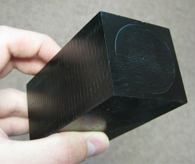Engineering
 |
|
A block of the hard, black tissue-equivalent plastic. Two smaller cylindrical blocks of this plastic are inside CRaTER. (Andrew Jordan) |
|
| |
 |
|
A schematic showing a cutaway of CRaTER's detectors and plastic. (NASA) |
CRaTER helps us understand how cosmic rays affect astronauts. Its six detectors are separated into three pairs. Two pieces of hard black plastic are placed between the pairs.
This plastic is a special type that mimics human tissue. It is called tissue-equivalent plastic or TEP. A cosmic ray deposits the same amount of radiation in the TEP as it would in human tissue.
Let's see how this works. A cosmic ray passes through the first pair of detectors (D1 and D2). Both detectors tell us how much energy the particle originally had.
If the cosmic ray has enough energy, it passes through the first piece of TEP. Along the way, however, it loses some energy to the TEP. This means that the TEP receives a small amount of radiation.
The cosmic ray may then pass through the next pair of detectors (D3 and D4). These detectors tell us that the cosmic ray has less energy than it began with. We compare the energy before and after it went through the TEP. The difference is the amount of radiation the TEP received.
Because TEP is like human tissue, this difference is also the amount of radiation that human tissue would receive. That is how we use CRaTER to measure how cosmic rays will affect future astronauts.
 |
|
